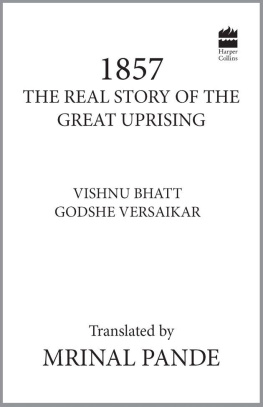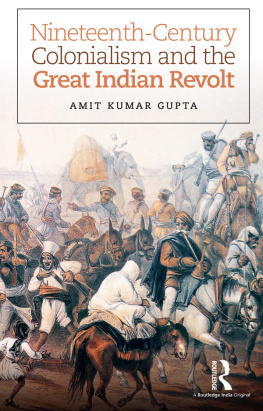1857
THE REAL STORY OF THE GREAT UPRISING
VISHNU BHATT GODSHE VERSAIKAR
Translated by
M RINAL P ANDE

NEW YORK LONDON TORONTO SYDNEY NEW DELHI AUCKLAND
Contents
A N OTE ON THE B OOK
Around the middle of the nineteenth century, when the East India Company had consolidated its hold over the Indian subcontinent, a Chitpavan Brahmin by the name of Vishnu Bhatt Godshe Versaikar decided to cross the rugged Vindhya mountains with his aged uncle to earn some money. He had not foreseen how his trip would coincide with the historic Sepoy Mutiny and play havoc with their travel plans. This is a unique first-person, eyewitness account of their picaresque journey, recorded several years after their return home. This is also perhaps the only documentation of a climactic event in the history of India by an impoverished but learned young beggar-priest.
Vishnu Bhatt belonged to the village of Versaihence the surname Versaikar, meaning, literally, of Versaia remote village in the Alibagh subdivision of the Kolaba district near what is now Mumbai in the state of Maharashtra.
How the book came to be written is also a rare story in itself. Having listened to the loquacious Vishnu Bhatt recounting his adventures during his journey up north, one of his clients, Rai Bahadur Chintamani Vinayak Vaidya, who practised traditional medicine as a vaidya, advised him to write it down for posterity. It was thus that, some twenty-four years after Vishnu Bhatts return, he penned down his memoirs. It took many more years for it to be published.
Painfully recorded accounts of major political upheavals need to be stored well if they are to be handed to posterity. Since post-1857 India was still tense and reprisals by the British were swift and dire, after he had completed the manuscript, Bhatt handed it to Vaidya for safekeeping. Both feared reprisals at the hands of the British for writing on a sensitive subject, and so Vishnu Bhatt requested that his travelogue be published only after his death. To his credit, Vaidya kept the 297-page manuscript safe with him for two decades, until Vishnu Bhatt passed away in 1903, at the age of seventy-five.
When Vaidya finally set about preparing the manuscript for publication, he edited out some portions he considered unnecessary. He felt that he should reshape the book to make it seem like a work of fiction; Vishnu Bhatt would then appear as a fictional hero narrating events. The book was finally published in 1907, on the occasion of the golden jubilee of the Mutiny, by not one but two publishing houses: Indu Prakash and Chitrashala Press, Pune. According to Vaidya (as told to the members of the Bharatiya Itihas Shodhak Mandal, a group of Indian historians to whom he was later to hand the original manuscript, intact), he, like the original writer, had also earlier feared penalization by the British government and had felt that camouflaging it as a novel would ward off trouble. As a safety measure, Vaidya got the book published simultaneously by two publishing houses, so that if one copy was banned, another would survive.
Vishnu Bhatt had written his account in old-style Marathi in the traditional Modi script and had neither divided the story into separate chapters nor given the manuscript a clear title. He only gave it a subtitle: 1857 Chya Bandachi HakikatA Factual Account of the 1857 Mutiny. However, each part, where a particular series of events ends, is signed by him. This makes the job of segregating the chapters easier for editors.
The deeply devout Vishnu Bhatt begins the book with a one-line invocation to Lord Ganesh: Shri Gajanana Prasanna, Bhag Pahila, PrastavanaMay He with the face of an elephant, Shri Gajanana, be pleased. It ends with a homage to Lord Shiva: Shri Parthivlingroopi Sadashivay NamahI bow to Lord Shiva in his manifestation as a Parthiva lingam. The narration is followed by a short traditional falshruti (a philosophical gist of lessons to be drawn from a particular experience) entitled, Pravasache Falit.
This translation follows the original text prepared for publication (on behalf of the Bharatiya Itihas Shodhak Mandal) by historians Datto Vaman Potdar and Prof. N.R. Phatak. Both were Bhatts admirers and had reacted sharply to editorial liberties taken by Vaidya, such as inserting sundry Sanskrit couplets into each chapter and the chopping off of several what he felt could be offensive portions. They pointed out that as edited by Vaidya, the book reads more like a kadambari (novel), with the writer Vishnu Bhatt as a mere character and not as an honest-to-goodness account of a major historic event. Their version closely follows the original and is written in the present-day Marathi script. It was published in 1948 by the Bharatiya Itihas Shodhak Mandal. Two CDs of the manuscript are also available.
The well-known Hindi writer Amritlal Nagar was given a copy of Maajha Pravas by his friend, the Marathi humorist Shamrao Neelkanth Oak, to read. He translated it into Hindi; this translation was published by Messrs Rajpal and Sons. Shri Nagar was aware of the history of the two texts and has criticized Vaidya in his preface to the book for the liberties taken by him in rewriting Vishnu Bhatts account. But strangely enough, when he began to translate it into Hindi, he chose to use Vaidyas version, which he was aware leaves out several important areas of information.
The full text, as published by the Bharatiya Itihas Shodhak Mandal, was later translated into Hindi by a journalist, Madhukar Upadhyaya, and published by Vani Prakashan in 2007.
In preparing the English version, apart from the Marathi original version (edited by Dr Phatak), I have also been greatly helped by the two Hindi translations by Shri Nagar and Madhukar Upadhyaya. This English translation results from joint urgings of two stalwarts of Hindi literature: the late Amritlal Nagar and my mother Shivani. Both had urged me, time and again, to translate this travelogue into English one day, so that it could reach a wider audience across India.
M RINAL P ANDE
May He with the face of an elephant,
Shri Gajanana, be pleased
I was born in the Saka year 1749 (AD 1827), in the monsoon month of Shravana, in a Brahmin family in a farming village known as Versai. This village is in the Pein taluka in the district of Alibagh and is located on the banks of a river that flows along a hill. It has an ancient Shiva temple and is well known as a village of learned Brahmin pandits, most of whom belong to the Chitpavan sect. We earn a living by putting our traditional learning to use by performing various kinds of rituals for clients in the surrounding villages. Most of us must supplement the meagre income generated by this work with alms.
Ours is a family of Godshe Brahmins of the Shandilya gotra or sub-caste, specializing in the study of the Rigveda, and we are some of the oldest inhabitants of the village. My noble fathers name is Balakrishna and my dear mother is known as Radha Bai. I, Vishnu Bhatt, am their firstborn. I have two younger brothers, Hari Pant and Dhond Bhatt, and a sister, Krishna Bai. My father has two learned brothers, Keshav Bhatt and Ram Bhatt, but here, in the village, Father is the sole supporter of the household. Father used to work with Sardar Vinchurkar, a nobleman from the court of Srimant Baji Rao Peshwa. After the decline of the Peshwa empire of Pune, Sardar Vinchurkar decided to migrate up north to Bithur, in what we know as Hindustan. Father was still keen to continue serving the Srimant and was willing to migrate with him to Hindustan. Despite ill health, he accompanied Sardar Vinchurkar up to the river Narmada, but he had to abandon his plans and come back after he developed a high fever.
Next page








